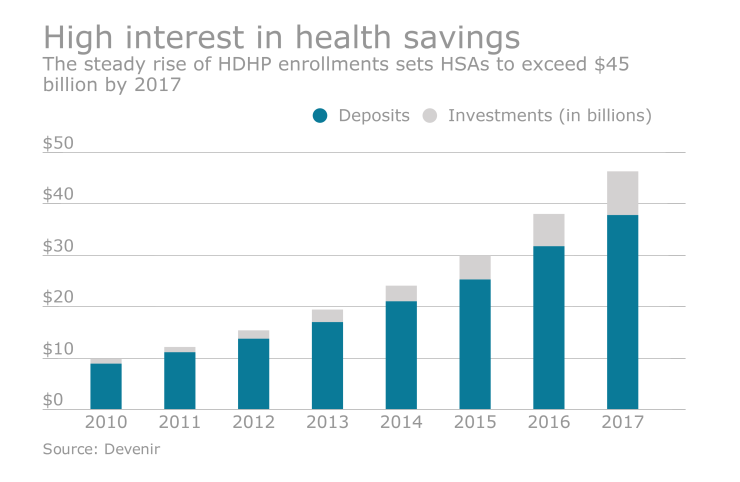Health savings accounts are being buoyed by bullish forecasts and the potential for delivering more strategic input.
HSA balances grew by more than a third in 2015, according to the most recent results from the third annual Employee Benefit Research Institute HSA Database. The average HSA balance edged up to $1,844 from $1,332 within the year, while average account balances increased with the age of the account holder. The findings are based on anonymous data from various HSA recordkeepers, including 4 million accounts with total assets of $7.4 billion as of 2015.

Paul Fronstin, director of EBRI’s Health Research and Education Program, thought it was interesting that account balances grew as much as they did. “We show about a $500 increase in account balances,” he says, “but it’s actually more than that when you look at accounts with contributions where balances went up by about $800. It’s a pretty big jump.”
EBRI focuses on accounts with contributions because as many as 40% of accounts in the database had no such activity. Fronstin says the latter category could be traced in part to former employees whose accounts are dormant, though money still could be withdrawn.
Also see: “
Overall, the number of HSAs rose to 18.2 million as of June 30, 2016, a 25% increase from the same period last year, noted the 2016 Midyear Devenir HSA Research Report. The number is projected to surpass 27 million by the end of 2018. These accounts hold more than $34.7 billion in assets, with an annual increase Devenir pegs at 22%.
An estimated 20 million policyholders and their dependents were enrolled in HSA-eligible health plans in 2015, with 16.7 million accounts holding $30.2 billion in assets, according to EBRI, while 85% of HSAs were opened since 2011.
Brokers and advisers can play a critical role educating employers and employees alike about the merits of HSAs, as well as helping set the right contribution level and navigate employees through the process of choosing this option, Fronstin says.
There are three different types of HSA users involving spenders, savers and investors, says Jim Lynch, chief sales officer of WageWorks, a leading on-demand provider of tax-advantaged programs. “Most people in the first year or two are really in that spend mode,” he observes. As time marches on and they build a balance, he says brokers and advisers can promote other products or vehicles to help maximize those savings.
“We have a really strong open-enrollment kit that touches on each component,” he says, noting a need to retool and customize messages along each leg of the transition from spending to saving to investing. This incremental approach could help maximize both participation and savings.
Lynch cites a triple tax advantage and portability as tremendous selling points. “The funds are going to roll over, and you’re not going to be forced to run out and buy a pair of eyeglasses at year end like you have done in the past with FSAs,” he explains. “Down the road, you’re going to have 30-some-odd investment options available to you. So they start to think of it along the lines of this is a long-term strategy plan, and I get to keep my money… “Even if I leave, it’s portable, and I take it with me.”
Bullish forecast
There’s little doubt the future of HSAs looks bright. “Nearly 30% of employers offered an HSA-eligible health plan in 2015, and that percentage is expected to increase in the future both as a health plan option and as the only health plan option,” according to Fronstin.
President-elect Donald Trump’s pledge to repeal and replace the Affordable Care Act could be one such catalyst. Still, Fronstin points to tremendous growth potential, “regardless of public policy,” and believes the accounts could be expanded in a couple of different ways. They include allowing account holders to make contributions or easing restrictive requirements such as excluding secondary preventive services from annual deductibles.
An estimated $4.7 billion in HSA investment assets by the middle of June represents a 23% annual increase from the previous mid-year period, according to Devenir, which also notes that the average investment account holder has a $15,092 total balance.
The investment-option component could become more valuable in HSAs as consumers build their account balances, Lynch believes. “Some of the studies suggest anywhere from about 3% to 5% of the HSA holders invest their money, but that actually adds up to be about 17% to 20% of the assets,” he explains.
For brokers who view HSAs as eroding commissions on coverage featuring lower monthly premiums and higher annual deductibles, other opportunities could arise. For example, account savings could be earmarked for voluntary products. “It adds up because of the triple tax advantage,” Lynch reiterates. They also could reap the many benefits associated with providing a more consultative approach to clients.





